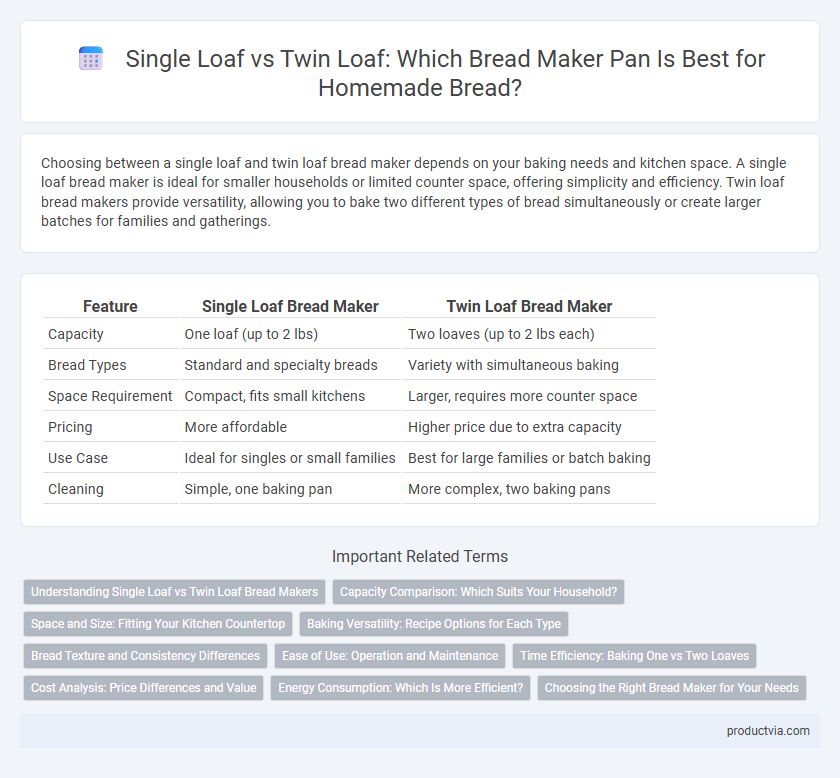Choosing between a single loaf and twin loaf bread maker depends on your baking needs and kitchen space. A single loaf bread maker is ideal for smaller households or limited counter space, offering simplicity and efficiency. Twin loaf bread makers provide versatility, allowing you to bake two different types of bread simultaneously or create larger batches for families and gatherings.
Table of Comparison
| Feature | Single Loaf Bread Maker | Twin Loaf Bread Maker |
|---|---|---|
| Capacity | One loaf (up to 2 lbs) | Two loaves (up to 2 lbs each) |
| Bread Types | Standard and specialty breads | Variety with simultaneous baking |
| Space Requirement | Compact, fits small kitchens | Larger, requires more counter space |
| Pricing | More affordable | Higher price due to extra capacity |
| Use Case | Ideal for singles or small families | Best for large families or batch baking |
| Cleaning | Simple, one baking pan | More complex, two baking pans |
Understanding Single Loaf vs Twin Loaf Bread Makers
Single loaf bread makers typically feature one baking pan with capacities ranging from 1 to 2 pounds, ideal for households needing fresh bread without excess storage. Twin loaf bread makers offer two separate baking pans that can bake different types or flavors of bread simultaneously, providing versatility and efficiency for larger families or multitasking bakers. Selecting between single loaf and twin loaf machines depends largely on your bread consumption, variety preferences, and kitchen space constraints.
Capacity Comparison: Which Suits Your Household?
Single loaf bread makers typically produce one standard-sized loaf, usually around 1 to 2 pounds, ideal for small households or individuals. Twin loaf machines offer the convenience of baking two loaves simultaneously, often with variable sizes ranging from 1 to 2 pounds per loaf, making them perfect for larger families or those who consume bread frequently. Selecting between single and twin loaf bread makers depends on your household size, bread consumption habits, and desired baking capacity.
Space and Size: Fitting Your Kitchen Countertop
A single loaf bread maker typically measures around 10-12 inches wide and occupies less countertop space, making it ideal for compact kitchens or limited counter areas. Twin loaf bread makers are significantly larger, often 15-18 inches wide, requiring more room but allowing the simultaneous baking of two loaves, which suits larger households or frequent bakers. Considering your kitchen countertop dimensions is essential to choose between the compact convenience of a single loaf or the capacity advantage of a twin loaf bread maker.
Baking Versatility: Recipe Options for Each Type
Single loaf bread makers excel in baking a wide variety of artisan and specialty bread recipes, offering precise control over kneading and rising times for unique textures. Twin loaf bread makers provide the advantage of baking two different types of bread simultaneously, perfect for households requiring multiple varieties or larger quantities. Recipe options for single loaf machines often emphasize creativity, while twin loaf models prioritize convenience and efficiency in variety.
Bread Texture and Consistency Differences
Single loaf bread makers typically produce a denser, more uniform crumb due to the concentrated heat distribution within a smaller baking chamber. Twin loaf bread makers offer greater versatility by baking two smaller loaves simultaneously, resulting in slightly varied textures--each loaf may have a lighter crust and more aerated consistency because of increased surface area exposure. Differences in dough kneading and rising times between single and twin models further influence the bread's moisture retention and crumb structure.
Ease of Use: Operation and Maintenance
Single loaf bread makers typically offer simpler operation with fewer controls and settings, making them ideal for beginners seeking straightforward use. Twin loaf bread makers can be more complex due to separate baking chambers and additional features, requiring more attention during operation and cleaning. Maintenance for single loaf models is generally quicker, while twin loaf machines may need more frequent and detailed cleaning to ensure optimal performance.
Time Efficiency: Baking One vs Two Loaves
Baking a single loaf in a bread maker typically requires less time compared to twin loaf settings due to reduced dough volume and shorter kneading cycles. Twin loaf bread makers enable simultaneous preparation of two loaves, saving overall kitchen time despite longer individual bake durations. Selecting between single and twin loaf options depends on balancing immediate time efficiency with batch productivity needs.
Cost Analysis: Price Differences and Value
Single loaf bread makers typically cost less, ranging from $50 to $150, while twin loaf models often start around $150 and can exceed $300 due to their larger capacity and dual baking pans. The price difference reflects added features such as simultaneous baking of two loaves, which increases productivity for families or small businesses. Evaluating value involves balancing upfront cost against the convenience of baking multiple loaves, with twin loaf machines offering savings over time for frequent bakers despite the higher initial investment.
Energy Consumption: Which Is More Efficient?
Single loaf bread makers generally consume less energy compared to twin loaf models due to their smaller capacity and shorter baking cycles. Twin loaf bread makers require more power and extended baking time to accommodate two loaves simultaneously, increasing overall energy consumption. Choosing a single loaf bread maker can result in more efficient energy use, especially for small households or occasional baking needs.
Choosing the Right Bread Maker for Your Needs
Selecting a single loaf bread maker offers convenience for smaller households, delivering perfect loaves up to 2 pounds, while twin loaf machines accommodate larger families or those seeking variety by baking two loaves simultaneously. Single loaf bread makers generally have a more compact design, making them ideal for limited kitchen space, whereas twin loaf bread makers require more counter area but provide versatility with different bread types or flavors at once. Prioritizing loaf size, baking frequency, and available kitchen space ensures the right bread maker aligns with individual baking preferences and lifestyle demands.
Single Loaf vs Twin Loaf for Bread Maker Infographic

 productvia.com
productvia.com